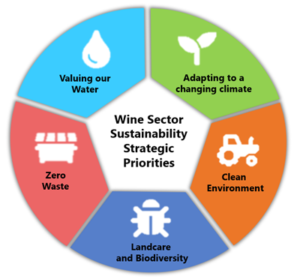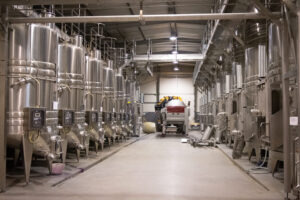Green is the new black – Sustainability in wine (1/3)
The latest D6 paper focussed on sustainability in wine – environmental, economic and social. Topics close to my heart and worth looking at with a critical eye. The journey took me beyond popular green-energy-centred environmentalism, back to a more basic definition of ‘sustainable’: maintaining present behaviour without harming future generations’ chances at functionality, wealth and wellbeing.
Sustainability is hot, inspiring new processes, products and technologies. But these solutions also consume energy and resources to come about: people’s time and attention, electricity, materials, chemicals and water for production and cleaning operations. Additionally, new technologies tend to make older equipment redundant, resulting in functional hardware being discarded to end up as waste in incinerators or landfill. Sustainable technologies should therefore not be produced and implemented thoughtlessly. In a truly sustainable wine industry, decisions need to be based on independent research, analysis and measurable data. Good intentions and a feel-good factor are important motivators and should therefore not be overlooked. Nevertheless, key actions should be guided by scientific fact and take the full lifecycle and energy balance into account. The paper’s first question dealt with water and energy in the winery. Agriculture, including viticulture, is the largest water consumer worldwide, accounting for 69% of water withdrawals. Producing a tonne of grapes and turning it into wine requires on average 870,000 litres of water. In the winery, each tonne generates 3000 to 4000 litres of wastewater, mainly from washing operations during grape reception, pressing, fermentation and cleaning equipment and bottles. Winemaking is energy intensive too, with heating, cooling, ventilation, lighting, compressed air and processing power as the biggest culprits. Because wine businesses differ in size, location, ethos and resources, there is no ‘one size fits all’ solution. Wineries need to evaluate what works for them, based on a long-term strategy and an integrated approach to cleaner, less wasteful production. This starts with measuring water and energy use, identifying where most expenditure occurs and where leaks and wastage can be addressed.
Water
 Sustainable Winegrowing New Zealand has championed water conservation for many years. 92% of their members already measure and record water usage and 71% have leak detection programmes. Analysing data like this can reveal ‘low-hanging fruit’ solutions: cheap, easy to implement, yet making a difference in wineries of all sizes. Wine conglomerate E. & J. Gallo, for example, started by measuring hose flow rates and involving employees via ‘water walks’, increasing awareness of water expenditure throughout the winery. They conserved water straightaway by switching hose nozzles, cleaning with pressure and steam instead of open hoses, pre-rinsing barrels with used water and installing drain covers to avoid grapes clogging up pipes. Other solutions involve larger investments: underground tanks to collect rainwater, UV-light bottling lines or wastewater plants to filter and treat water before reuse. In California, O’Neill Vintners and Distillers even built installations where worms convert wastewater into an eco-friendly soil-improving substance, and Cakebread Cellars landscaped their parking lot with drought-tolerant native plants, permeable pavers and bioswales to collect stormwater. Because of the substantial costs embedded in water transport, heating and treatments, water-saving solutions also help conserve energy.
Sustainable Winegrowing New Zealand has championed water conservation for many years. 92% of their members already measure and record water usage and 71% have leak detection programmes. Analysing data like this can reveal ‘low-hanging fruit’ solutions: cheap, easy to implement, yet making a difference in wineries of all sizes. Wine conglomerate E. & J. Gallo, for example, started by measuring hose flow rates and involving employees via ‘water walks’, increasing awareness of water expenditure throughout the winery. They conserved water straightaway by switching hose nozzles, cleaning with pressure and steam instead of open hoses, pre-rinsing barrels with used water and installing drain covers to avoid grapes clogging up pipes. Other solutions involve larger investments: underground tanks to collect rainwater, UV-light bottling lines or wastewater plants to filter and treat water before reuse. In California, O’Neill Vintners and Distillers even built installations where worms convert wastewater into an eco-friendly soil-improving substance, and Cakebread Cellars landscaped their parking lot with drought-tolerant native plants, permeable pavers and bioswales to collect stormwater. Because of the substantial costs embedded in water transport, heating and treatments, water-saving solutions also help conserve energy.
Energy
Sustainable energy use in wineries should focus on two aspects: energy conservation throughout the winery and renewable energies. Here too businesses should map and measure expenditure and consider low-hanging fruit measures before making expensive investments. Studies in office buildings showed energy savings up to 41% from simple measures like window blinds, adjusting thermostats and switching lights and equipment off when leaving. Energy cost can also be considered in employee travel, everyday transport and selecting marketing materials. Producers can favour eco-friendly packaging, such as recycled wine boxes or lighter bottles, which save energy in production and/or transport. Bag-in-box, aluminium cans or bottles, kegged wines on tap and wine bottles made from recycled paperboard have much lower lifecycle impact than single-use glass. Or wineries can participate in bottle reuse projects.
 For winery buildings, experts recommend comprehensive energy management, centred around energy-efficient passive construction, insulation, refrigeration, renewable energy and – still problematic – energy storage. Options depend on the winery’s environment, size and resources. A few examples:
For winery buildings, experts recommend comprehensive energy management, centred around energy-efficient passive construction, insulation, refrigeration, renewable energy and – still problematic – energy storage. Options depend on the winery’s environment, size and resources. A few examples:
- utilising natural caves, existing cellars or constructing underground. In Pessac-Léognan, Smith Haut Lafitte’s chai furtiff operates without any electric cooling;
- Asti Winery (Cloverdale) saves 1.6 million kWh annually by using natural daylight and energy-efficient lighting with motion sensors, insulating 93 wine tanks and installing variable speed drives to adjust the speed of compressors and fans;
- in hot, arid Paso Robles, Lohr cut energy costs by installing two high-speed roll-up doors. Previously, doors were left open during production hours for easy access;
- a 20
20 New Zealand trial showed that pulse cooling tanks, pumping coolant through refrigeration jackets in intervals, uses 70% less energy.
For their remaining energy needs, wineries can favour renewable sources. However, to be truly sustainable, they should factor in the material, environmental and energy costs of harnessing and transporting energy, and avoid outsourcing environmental costs to developing countries.
Despite concerns about visual aspects, impact on wildlife and microclimates, wind energy is one of the cleanest energies. Wind turbines come in different sizes, suitable for a range of wineries, but location is key for optimal performance, favouring open plains, hilltops, mountain gaps or bodies of water.
Solar and photovoltaic panels are generally suitable for wineries, since most are in medium to high solar radiation areas and there is a seasonal match between peak energy consumption and higher radiation times. But it is intermittent, depending on sunshine, and therefore often complemented with other technologies. In California, for example, Trinchero Family Estates and Stone Edge Farm combine solar energy with fuel cells: electrochemical energy-conversion devices working on hydrogen. Alternatively, Montepulciano’s Salcheto blends photovoltaic, geothermal and biomass solutions. The latter, where grape stems, pomace and lees are converted into biofuels, also addresses waste disposal issues.
Many measures are not feasible – nor desirable – for all wineries. However, sustainability can be factored into choosing suppliers and services, as more sustainable solutions become increasingly available.
Continued in part 2.
This article is based on the July 2022 D6 paper Kristel submitted. Read it here.
Kristel passed this paper with distinction, a mark that few achieve for this unit within the WSET Diploma course.










